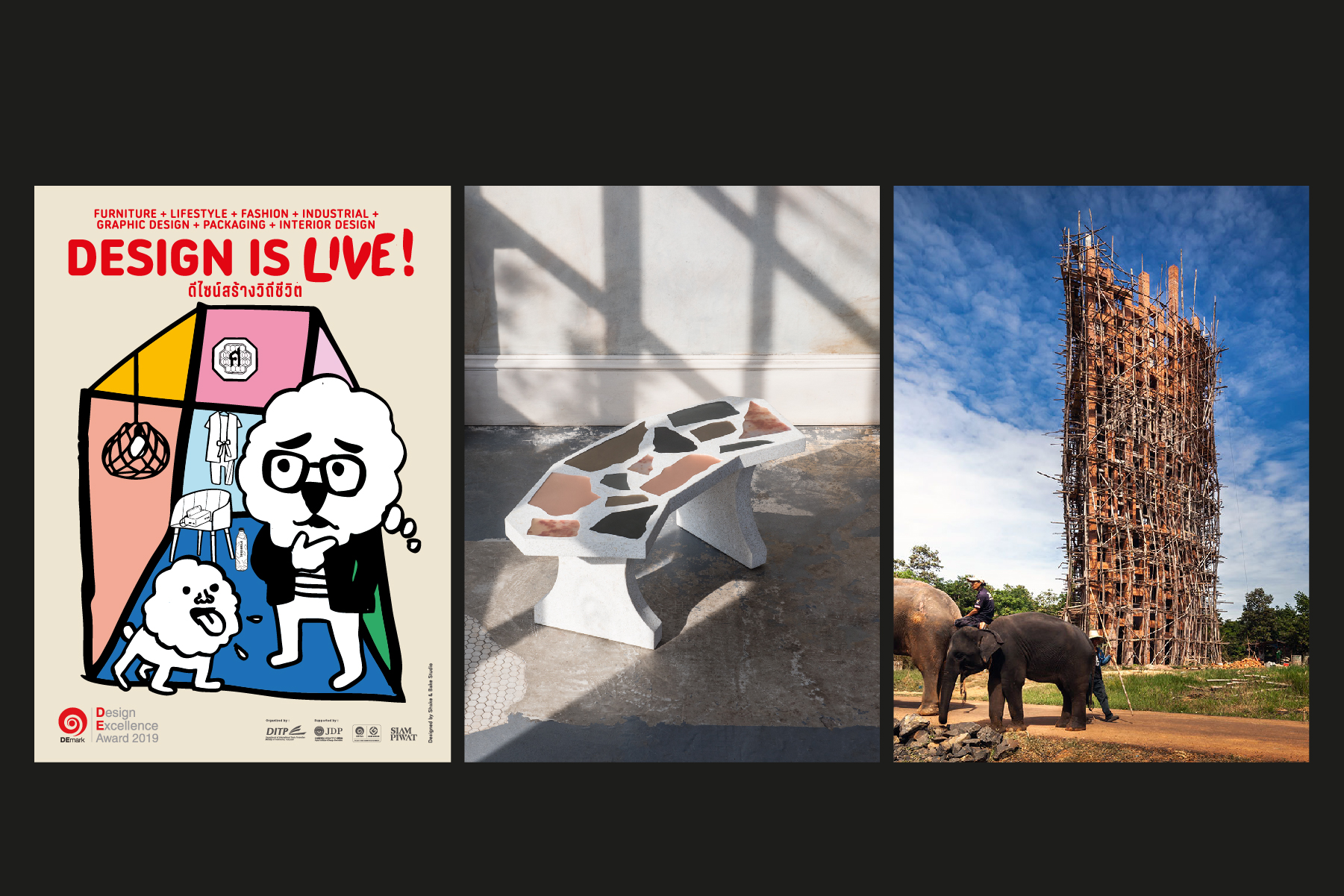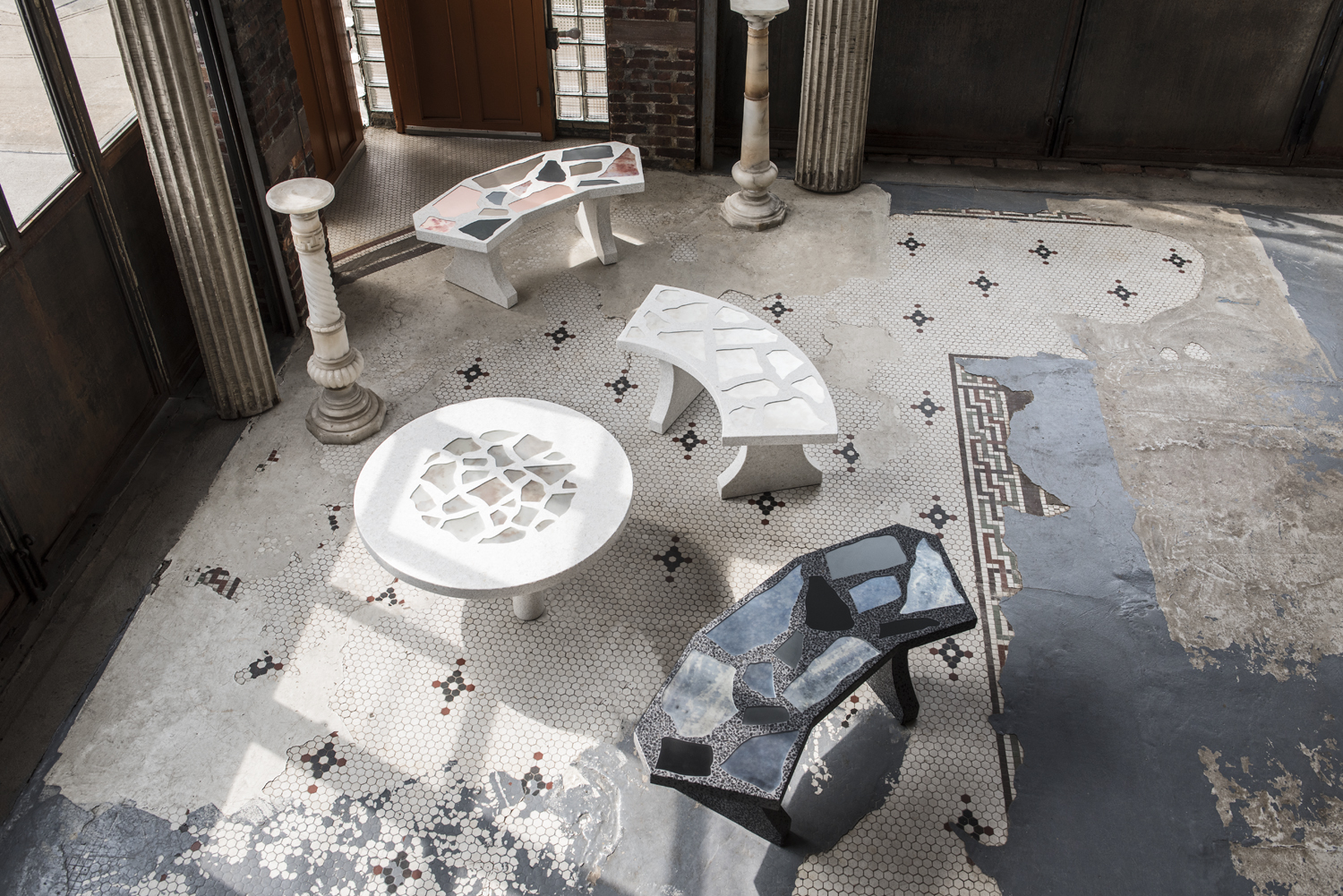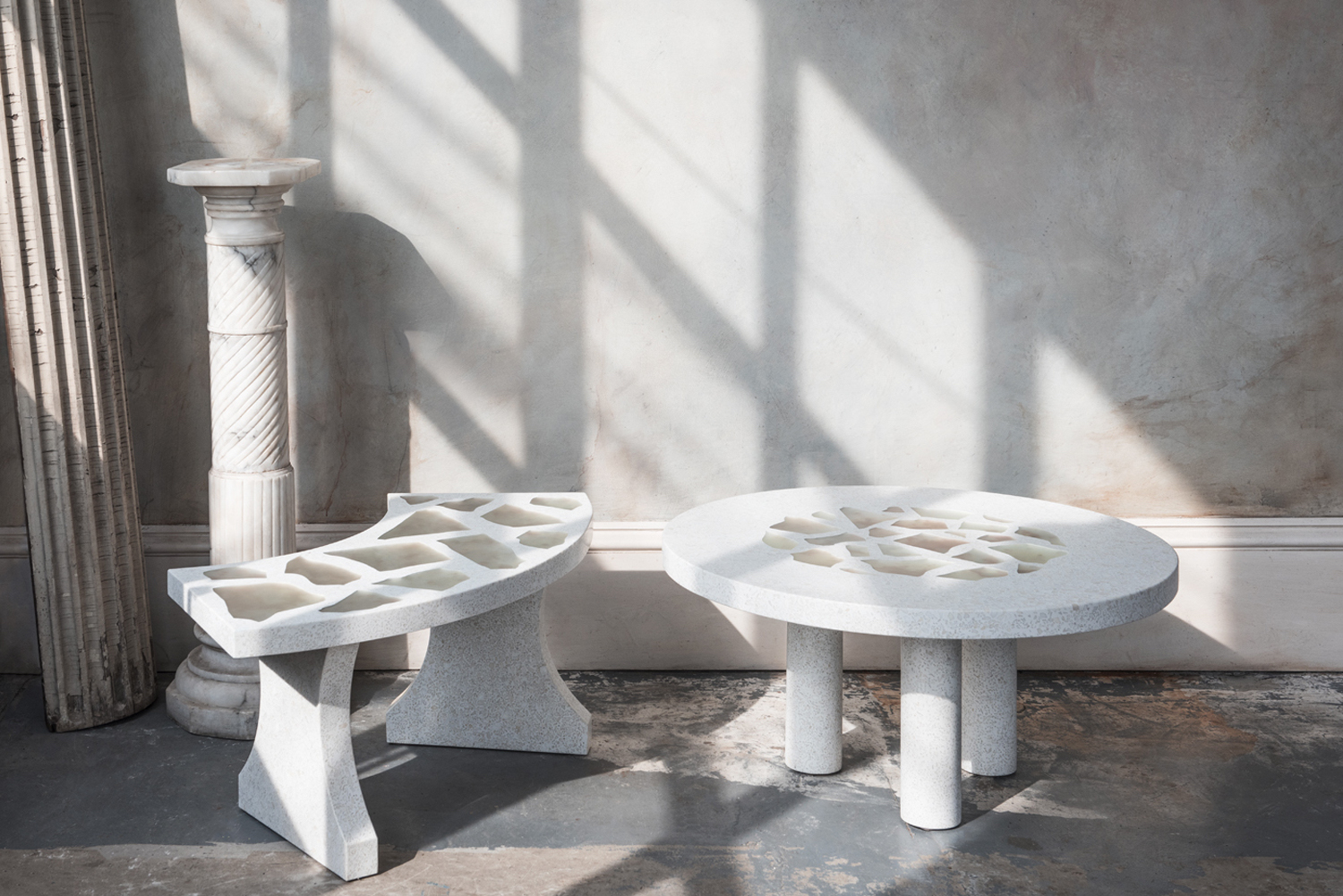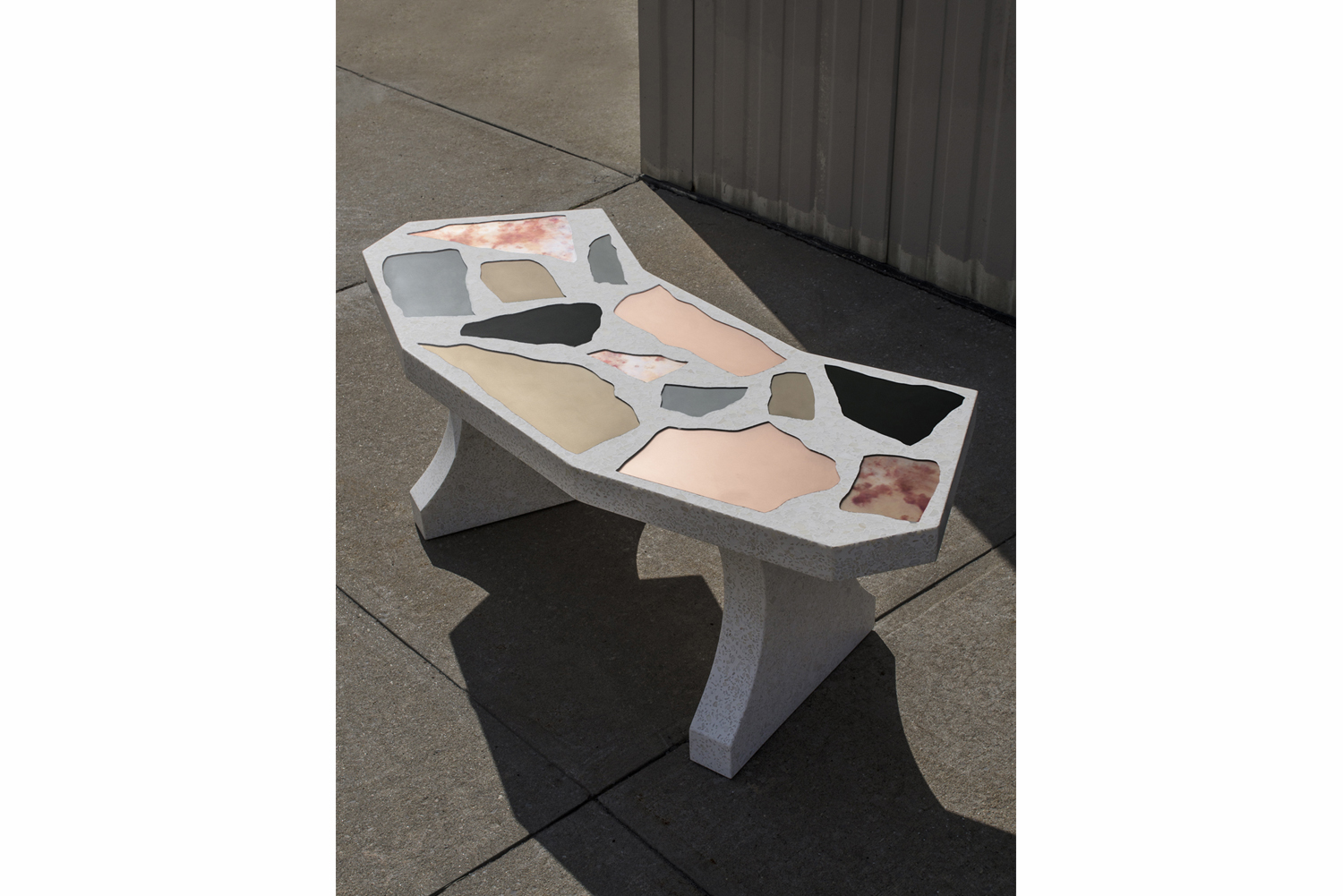WHAT’S GOING ON IN ARCHITECTURE, DESIGN AND THE ART SCENE AROUND THE WORLD. LET’S SEE ON ART4D WRAP UP WEEKLY
TEXT: SUTEE NAKARAKORNKUL EXCEPTED AS NOTED
MAIN IMAGE COURTESY OF SHAKE & BAKE STUDIO / DEMARK AWARD 2019 /
ROBERT SUKRACHAND / SPACESHIFT STUDIO

THOUGHT AND YIM FOR DEMARK AWARD 2019
Animation courtesy of Shake & Bake Studio / DEmark Award 2019
หลังจากเมื่อปีที่ผ่านมา Shake & Bake Studio ได้รับรางวัล DEmark Award ในประเภทกลุ่มกราฟิกดีไซน์ จากผลงานออกแบบ identity design คาแร็คเตอร์ ‘นกสายฟ้า’ (Thunder Bird) ให้กับโฮสเทลที่เชียงใหม่ มาในปีนี้ Shake & Bake Studio ก็ได้รับโอกาสให้เป็นผู้ออกแบบ Key-Visual ของงาน DEmark Award 2019 ที่มาพร้อมกับคาแร็คเตอร์สองตัว ที่มีชื่อว่า THOUGHT กับ YIM
THOUGHT ไม่ใช่นักออกแบบแต่ชอบเสพงานออกแบบ เขาสวมใส่แว่นตาแบบที่นักออกแบบมักจะใส่กัน มีส่วนจมูกและปากมาจากตัวนาก เวลาอยู่บ้านใส่เสื้อลายขวาง และใส่ Blazer เวลาออกงานตลอดเวลา ส่วน YIM ที่เป็นเพื่อน THOUGHT นั้น ดูรวมๆ แล้วคล้ายหมาแต่ก็ไม่ใช่หมา YIM มีหน้าตาคล้ายๆ คนที่ยิ้มอยู่ตลอดเวลา (แม้กระทั่งเวลาแลบลิ้นก็ยังยิ้ม) มันไม่คิดว่าตัวเองเป็นสัตว์เลี้ยงของ THOUGHT แต่จะซึมซับงานออกแบบรอบๆ ที่ THOUGHT เอากลับมาที่บ้านแทนการกินอาหาร ปิยพงศ์ ภูมิจิตร ผู้ก่อตั้งสตูดิโอ บอกกับ art4d ว่าไอเดียของคาแร็คเตอร์สองตัวนี้ มาจากความยากในการออกแบบ “เพราะต้องคิดกับการออกแบบคาแร็คเตอร์ตัวนี้มากๆ จึงทำให้นึกถึงคนที่กำลังคิดอะไรอยู่” นี่เป็นเหตุผลที่หัวของคาแร็คเตอร์ 2 ตัวนี้ออกมาเป็นตัวการ์ตูนที่มีหัวเป็นบับเบิลของการคิด แบบเดียวกันกับบับเบิลคำพูดในมังงะ
“เราคิดว่า THOUGHT กับ YIM จะเหมาะทีเดียวกับการเชิญชวนดีไซเนอร์ให้ร่วมส่งผลงานมาเข้าร่วม DEmark Award ปีนี้” DEmark Award ปีนี้มาในธีม “Design is Live!” ก็ต้องลองมาดูกันว่าคาแร็คเตอร์สองตัวนี้จะเชิญชวนคนมาสมัครได้มากน้อยแค่ไหน และที่น่าสนใจมากกว่าก็คือ จะมีใครเอาคาแร็คเตอร์ที่ถูกออกแบบให้เรียบง่าย ใช้แค่สีขาว – ดำ ไปวาดต่อเป็นเรื่องราวตอนต่อไปของ THOUGHT กับ YIM หรือไม่?
After winning DEmark Award in the Graphic Design category last year with the identity design, ‘Thunder Bird’, he did for a hostel in Chiang Mai, Piyapong Bhumichitra of Shake & Bake Studio is chosen to be the designer of DEmark Award 2019’s Key-Visual.
The two characters he comes up for this project are named THOUGHT and YIM. THOUGHT isn’t exactly a designer, but he does profess great love design. He wears the kind of glass that designers like to wear. With the nose and mouth of an otter, he usually sports a casual look of a horizontal stripe t-shirt while at home and ALWAYS wears a blazer when attending social events. YIM, his friend, looks kind of like a dog but not entirely a dog. His face looks like he’s always smiling (even when he pokes out his tongue). He doesn’t think of himself as THOUGHT’s pet, but he does feed of all sorts of design works THOUGHT brings home instead of food. Bhumichitra told art4d that the ideas he has for the two characters come from the difficulty of the design process itself. “The fact that I had to put so much thoughts into developing these two characters got me thinking about a person who’s thinking intensely about something.” It explains why the heads of both THOUGHT and YIM reminisce the shape of a speech balloon in a manga.
“I think THOUGHT and YIM will be great at representing DEmark Award in calling for designers to submit their projects.” Themed “Design is Live!”, it remains to be seen how much this year’s DEmark Award will be attracting entries with the two characters as its face. Also, seeing the two characters, (drawn with simple lines and black and white color) being developed into a more elaborate story would be something to look forward to.

MIRAZZO
Photo courtesy of Robert Sukrachand
Robert Sukrachand ดีไซเนอร์ลูกครึ่งอเมริกัน-ไทย ที่ทำงานอยู่ในนิวยอร์ก ได้ออกแบบเฟอร์นิเจอร์คอลเล็คชั่น Mirazzo ที่ประกอบไปด้วยม้านั่งสามตัวและโต๊ะกาแฟ โดยได้รับแรงบันดาลใจมาจากการเดินทางมาเยี่ยมบ้านคุณพ่อที่ประเทศไทย ระหว่างนั้น Sukrachand เดินทางมาที่กรุงเทพฯ และสังเกตเห็นความคล้ายคลึงกันระหว่าง terrazzo กับพื้นผิวของม้านั่งหิน street furniture ที่มีเอกลักษณ์เฉพาะตัว ไม่ว่าจะเป็นม้านั่งริมถนน และโต๊ะกระดานหมากในสวนสาธารณะ ที่เขาเรียกมันว่า “นี่คือ terrazzo แบบไทยๆ”
พื้นผิวที่ตามปกติแล้วจะเป็นลวดลายของหินขัดหลากสี ถูกบุด้วยเศษกระจกและแก้วที่เหลือทิ้งจากผลงานในคอลเล็คชั่นก่อนหน้าของ Sukrachand เพื่อลดขยะจากการผลิต ม้านั่งฮารูน ‘Haroon bench’ เป็นแบบจำลองม้านั่งหินสองตัวที่เขาเห็นเป็นครั้งแรก บริเวณริมถนนตรงกันข้ามกับมัสยิดฮารูน ซึ่งตั้งอยู่ในชุมชนมุสลิมย่านเจริญกรุง ตัวหนึ่งเป็นม้านั่งสีดำ และอีกชิ้นมีสีขาว ในขณะที่ ‘Traimit bench’ ม้านั่งไตรมิตร เป็นชุดเก้าอี้และโต๊ะกาแฟเตี้ยๆ ที่ตั้งชื่อตามวัดไตรมิตรวิทยารามวรวิหาร ทำจากหินอ่อนสีขาว บุพื้นผิวหน้าโต๊ะและเก้าอี้ด้วยกระจกเวนิส Sukrachand บอกกับ art4d ว่า ตอนเดินทางมาที่กรุงเทพฯ เป็นช่วงเดียวกับงาน Bangkok Design Week 2019 พอดิบพอดี ทำให้เขาได้พบกับนักออกแบบชาวไทยหลายคน และรู้สึกประทับใจกับ scene ของงานออกแบบในกรุงเทพฯ พร้อมกับคาดหวังว่าในอนาคตจะได้มีโอกาสทำงานร่วมกับนักออกแบบชาวไทยบ้าง คอลเล็คชั่น Mirazzo กำลังจัดแสดงอยู่ที่ ‘Inside/Out’ นิทรรศการ contemporary outdoor furniture ครั้งแรก ภายในงาน NYCxDESIGN 2019 ที่นิวยอร์ก ระหว่างวันที่ 10 – 28 พฤษภาคมนี้
New York-based Thai-American designer, Robert Sukrachand, releases a furniture collection, Mirazzo where he introduces a set of three benches and coffee table whose design inspired by the time he spent visiting Thailand, his father’s home country. Sukrachand noticed the similarities between terrazzo and the surface of the street furniture commonly found in the streets and public spaces in the capital city of Thailand, to which he refers to as the ‘Thai terrazzo’.
The colorful patterns of terrazzo used for his collection are made of scraps of glass leftover from the making of his previous collection, which is Sukrachand’s intention to upcycle the waste from the production process of his furniture. ‘Haroon bench’ is a pair of black and white benches, and an interpretation of the two benches he saw for the first time across the street from Haroon Mosque in a Muslim community of Bangkok’s Charoenkkrung neighborhood. Made of white marble with Venice glass-cladded top, ‘Traimit bench’ is a set of coffee table and a bench named after the famous Traimit Temple in Bangkok. With his latest visit to Bangkok happens to be the time when the city was hosting Bangkok Design Week 2019, it granted him an opportunity to meet several Thai designers. Impressed by the thriving design scene of Bangkok, Sukrachand told art4d that he hopes to be able to collaborate with other Thai designers for his future projects. The Mirazzo Collection is currently showcased at ‘Inside/Out’, the first contemporary outdoor furniture exhibition held as a part of NYCxDESIGN 2019, which takes place between from 10th to 28th May 2019 in New York.

BOONSERM PREMTHADA WINS THE 2019 ROYAL ACADEMY DORFMAN AWARD
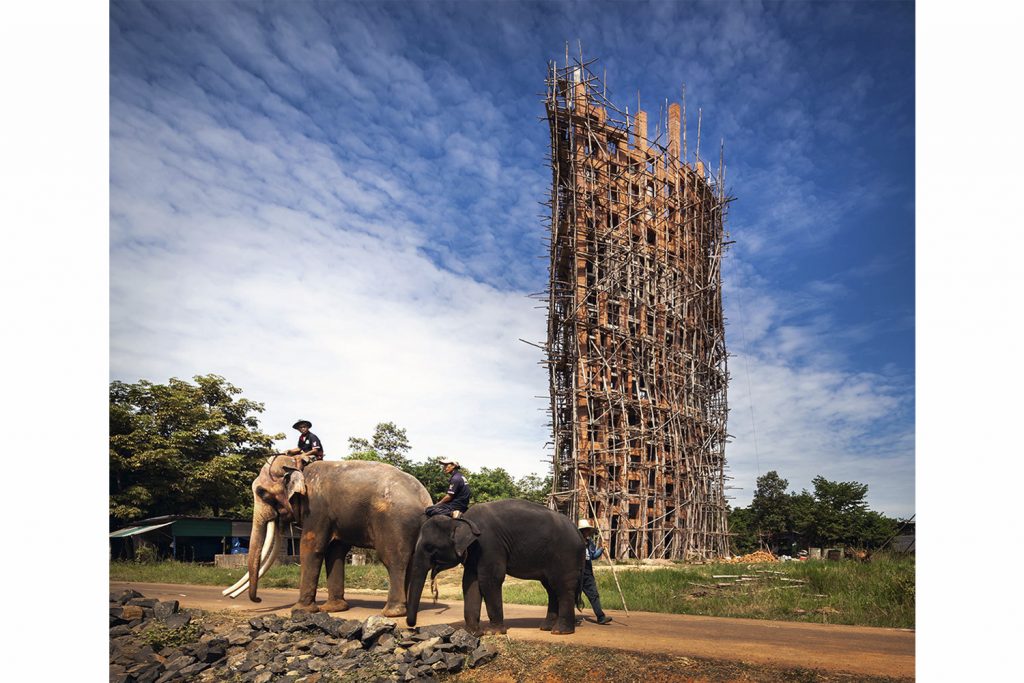
Photo: Spaceshift Studio
บุญเสริม เปรมธาดา จาก Bangkok Project Studio ได้รับรางวัล 2019 Royal Academy Dorfman Award จาก The Royal Academy of Arts สหราชอาณาจักร
The Royal Academy of Arts เป็นองค์กรทางด้านศิลปะของสหราชอาณาจักรที่เป็นทั้งที่จัดแสดงและสนับสนุนการสร้างสรรค์ศิลปะที่มีประวัติมายาวนานมากกว่า 250 ปี รางวัล Royal Academy Dorfman เป็นรางวัลที่ทางสถาบันตั้งขึ้นเพื่อสนับสนุนสถาปนิกที่ทำให้สถาปัตยกรรมมีบทบาทในการสร้างความเคลื่อนไหวด้านวัฒนธรรมให้กับโลก โดยทางคณะกรรมการจะทำการคัดเลือกรายชื่อผู้เข้าเสนอชื่อ และก่อนการประกาศรางวัลที่จะเลือกผู้ชนะเพียงคนเดียวจากรายชื่อผู้ได้รับการคัดเลือกทั้งหมดสี่คนในปีนี้ ทาง Royal Academy of Arts ได้จัดนิทรรศการ Architectural Futures เพื่อแสดงผลงานสถาปัตยกรรมโดยผู้เข้าร่วมชิงรางวัลโดยสี่บริษัทจากสี่ประเทศได้แก่
– Alice Casey and Cian Deegan, TAKA Architects จากไอร์แลนด์
– Mariam Kamara, Atelier Masōmī จากไนเจอร์
– Fernanda Canales จากเม็กซิโก
– บุญเสริม เปรมธาดา, Bangkok Project Studio จากไทย
ความเห็นของกรรมการ:
“ผมคิดว่าเราทุกคนประทับใจโครงการและการนำเสนอของคุณที่เต็มไปด้วยความเข้าอกเข้าใจ ความคิดสร้างสรรค์ และคุณภาพที่จับใจคน เรารู้สึกว่างานของบุญเสริมมีลักษณะเฉพาะตัวสูงมาก ในขณะเดียวกันเราก็อยากเห็นว่า วิธีเหล่านี้จะสามารถส่งต่อไปสู่การออกแบบของสถาปนิกของเราได้อย่างไร อีกเรื่องที่เราอยากรู้คือมุมมองในการทำงานที่มีลักษณะเฉพาะตัวแบบนี้ของคุณจะสามารถถูกปรับใช้เพื่อตอบสนองความท้าทายในการออกแบบอาคารในเมืองได้อย่างไรบ้าง”
บุญเสริม เปรมธาดา เป็นสถาปนิกที่มีผลงานให้เรารู้สึกตื่นเต้นกับสถาปัตยกรรมไทยร่วมสมัยอย่างต่อเนื่อง อย่างเช่นผลงานสามชิ้นที่ถูกยกเป็นตัวอย่างในนิทรรศการ ได้แก่ สถาบันกันตนา The Wine Ayutthaya และล่าสุดคือ Elephant World ที่แม้ว่าจะยังอยู่ระหว่างการก่อสร้าง แต่ก็ได้เผยให้ถึงคาแรกเตอร์ทางสถาปัตยกรรมที่มีแนวทางของตนเองอย่างชัดเจน นอกจากบทบาทการเป็นนักออกแบบ เขายังมีบทบาทเป็นอาจารย์ประจำภาควิชาสถาปัตยกรรมภายใน เราเห็นว่าการดำเนินสองบทบาทนี้มีผลต่อสถาปัตยกรรมของเขาที่มีความละเอียดอ่อนในการใช้วัสดุและนำมาซึ่งบุคลิกหรือสุนทรียภาพที่ผสมผสานระหว่างสถาปัตยกรรมสมัยใหม่และสถาปัตยกรรมทางประวัติศาสตร์
การใช้วัสดุของเขามักเกิดจากการทำงานเชิงทดลอง ในการดึงบริบททางวัฒนธรรมของวัสดุที่มีภาพจำบางอย่างมาประกอบกับรูปทรงจนเกิดเป็นบุคลิกของสถาปัตยกรรมในแต่ละชิ้น เช่น การใช้อิฐทำมือมาจัดเรียงแบบเข้าๆออกๆอย่างฐานปราสาทโดยประกอบกับโครงเหล็กทำให้เกิดกำแพงของสถาบันกันตนามีบุคลิกของซากปรักในอยุธยา ในขณะเดียวกันก็ลดทอนองค์ประกอบอื่นออกและออกแบบให้มีการวางผังแบบร่วมสมัย หรือการนำไม้อัดยางซึ่งเป็นวัสดุราคาไม่สูงมาทดลองจนเกิดเป็นไม้อัดเสริมเหล็กที่เป็นอัตลักษณ์ของ the Wine Ayutthaya วัสดุที่นำมาทดลองจนสร้างเป็นบุคลิกของแต่ละชิ้นงานมักเป็นวัสดุที่มีอยู่แล้ว แต่นำมาทดลองเพื่อหาแนวทางการออกแบบที่ต่างไปจากแนวทางที่ปฏิบัติต่อกันมาจนคุ้นเคยกัน จนนำไปสู่ภาพของการทดลองใช้วัสดุแบบใหม่ที่ไม่ยึดติดกับกรอบแบบแผนเดิม ๆ เช่น บล็อกแก้วที่มักถูกใช้เพื่อเป็นช่องแสง บุญเสริมใช้คุณสมบัติโปร่งแสงแต่ไม่โปร่งใส ลดทอนการรับรู้ระหว่างสองฝั่งไปบางส่วน และนำมันมาแปลงจุดประสงค์ให้มันเป็นวัสดุหลักของผนังในโครงการ the Kitchen และ Artisan Ayutthaya หรือแม้กระทั่งการใช้ไม้อัดยางที่ปกติแล้วมักเป็นสิ่งที่ถูกปิดซ่อนโดยการฉาบเคลือบหรือวัสดุปิดผิวต่างๆมาเป็นตัวชูโรงของ the Wine Ayutthaya
นอกจากการใช้งานวัสดุเพื่อบุคลิกของสถาปัตยกรรมแล้ว สิ่งทีตัวเขามักเน้นย้ำคือบทบาทของสถาปัตยกรรมที่มีกับชุมชน อิฐจำนวนหกแสนก้อนที่ใช้ในการทำกำแพงของสถาบันกันตนาล้วนเป็นอิฐทำมือจากโรงงานท้องถิ่นที่ได้รับการต่อลมหายใจโดยโครงการนี้ตามความตั้งใจของบุญเสริมที่ต้องการให้สถาปัตยกรรมเป็นสิ่งที่สร้างงานสร้างอาชีพ โดยเฉพาะแก่ผู้ประกอบอาชีพช่างฝีมือในท้องที่ ความเป็นนักกิจกรรมเช่นนี้ไม่เพียงแต่ดึงบริบทดั้งเดิมของพื้นที่ให้เป็นส่วนหนึ่งของเนื้อสถาปัตยกรรม แต่ยังมีผลต่อความสัมพันธ์ระหว่างสถาปัตยกรรมกับชุมชนที่จะมีต่อไปในอนาคต
แนวทางการทำงานและผลงานของบุญเสริมที่สร้างความต่างจากการเล่นกับ “ความใหม่-เก่า” ในบริบทสถาปัตยกรรมไทยร่วมสมัยนั้น ถึงแม้ว่าหากมองในกรอบคิดแบบโมเดิร์นแล้ว มันมักแฝงลักษณะของการจับคู่คุณลักษณะที่มีความเป็นคู่ตรงข้ามเพื่อสร้างผลลัพธ์ที่กระทบใจคนอยู่ ไม่ว่าจะเป็นกำแพงโครงสร้างเหล็กที่ปรากฏรูปลักษณ์เหมือนกำแพงอิฐก่อ หรือแนวคิดงานช่างฝีมือแบบอุตสาหกรรมของเขา ที่เขาพยายามใช้ฝีมือช่างที่เขาสนับสนุนมาประกอบเข้ากับวัสดุอุตสาหกรรม ซึ่งถึงมันจะดูเป็นการสร้างชื่อตั้งที่มีความขัดแย้งในตัวเองระหว่างความเป็นอุตสาหกรรม และความเป็นงานช่างฝีมือก็ตาม แต่นั่นก็ไม่ใช่เรื่องแปลกอะไรในโลกสถาปัตยกรรมที่ก็ดูจะโลดแล่นไปกับความขัดแย้งในตัวเองมาได้เป็นอย่างดีตลอดประวัติศาสตร์ของตัวมัน เพราะท้ายที่สุดรูปทรงปรากฏที่เรียบง่ายก็มักมีรายละเอียดที่ไม่เรียบง่ายและใช้ความพยายามอย่างสูงเพื่อให้ดูเหมือนไม่ต้องพยายาม แต่ก็คงต้องขอบคุณความเคลื่อนไหวจากคู่ขัดแย้งกันเหล่านี้ที่นำสถาปัตยกรรมไทยร่วมสมัยไปสู่เวทีระดับโลก และก็อาจจะนำไปสู่เส้นทางใหม่อีกเส้นทางหรือมากกว่านั้นในการทำงานสถาปัตยกรรมต่อไปในอนาคต
รออ่านเกี่ยวกับเนื้อหางานนิทรรศการรวมถึงผลงานที่จัดแสดงของผู้ได้รับการเสนอชื่อรับรางวัลนี้ทั้งหมดต่อเร็วๆ นี้ได้ใน art4d.com
____
A big congratulation to Boonserm Premthada for winning the 2019 Royal Academy Dorfman Award from The Royal Academy of Arts, the United Kingdom.
With the history that dates back to 250 years ago, the Royal Academy of Arts is one the UK’s most prestigious art institutions, serving as a platform that both showcases and promote the creations and appreciation of visual arts. The Royal Academy Dorfman Award is given to an architect, practice or collective who are reimagining the future of architecture and taking into consideration geographical and socio-political challenges.
The jury selects the four finalists before announcing the winner of the award. This year, Royal Academy of Arts puts together an exhibition titled ‘Architecture Futures’ to showcase the works of architecture by the four finalists from four different countries as follows:
– Alice Casey and Cian Deegan, TAKA Architects: Ireland
- Mariam Kamara, Atelier Masōmī : Niger
- Fernanda Canales : Mexico
– Boonserm Premthada, Bangkok Project Studio: Thailand
Jury’s opinions
“We were all knocked back by Boonserm Premthada’s particularly unique projects, which demonstrate an extraordinary empathy, originality and poetic qualities. We are excited to see how Premthada’s work develops, in particular how he can apply his inimitable approach to the challenges of urban environments.”
Boonserm Premthada is the architect whose works have never ceased to excite us about possibilities and potential of contemporary Thai architecture. The three projects featured in the exhibition, from the Kantana Film and Animation Institute, The Wine Ayutthaya and his most recent work-in-progress Elephant World, reveal his idiosyncratic architectural character and trajectory.
Apart from his role as a professional architect and designer, Premthada is currently working as a university professor in the department of interior architecture. The two roles have influenced his architecture in the way he delicately utilizes materials, resulting in the combined characteristics and aesthetics of modern and historical architecture found in his works.
His use of materials is often the result of an experimental approach in engaging cultural contexts of materials and a certain preconceived notions attached to them, before materializing them into architectural forms that embody the projects’ personalities. One of the examples is the way he designs the configuration of handmade bricks into the structure that is reminiscent of an ancient Thai stupa with its recessed walls forming corners around the lower base, reminding one of the ruins of ancient temples and castles of Ayutthaya. Other elements of the structure are simplified while the design is executed to contain a contemporary site plan. His experimentation on materials includes the creation of the inexpensive rubber plywood, in which he incorporates the use of reinforced steel structure into the unique architectural identity of The Wine Ayutthaya.
He often experiments on locally available materials, and through the process searches for new design approaches that break away from the existing conventions. Such method leads to unprecedented and experimental use of materials such as the use of glass blocks, which are usually used exclusively to dress up a wall with varying effects of light transmission. For the walls of The Kitchen and Artisan Ayutthaya, Premthada chooses glass blocks as the principle material for their translucent quality, which helps filter visual access from both sides of the functional space. With The Wine Ayutthaya, Premthada tests rubber plywood as the protagonist of the project instead of covering it with other cladding materials.
While his experimental use of materials contributes to his works’ unique identity, Premthada has always put great emphasis on the role of architecture on local community. Over 600,000 bricks used for the construction of the walls of Kantana Institute are handmade by the craftspeople working in the local brick factory, creating jobs for the struggling local establishment and the people living in the community. It follows Premthada’s intention for his architecture to help create jobs for local entrepreneurs and craftspeople. Such aspiration does not only incorporate the context of the site to be a part of the architecture he creates, but also affects the way architecture and community can be connected and interacted in the future.
Premthada’s approach and works differentiate themselves from others through the playing with the ‘old and new’ in the context of contemporary Thai architecture. Even one were to look at his works with the modern mindset and framework, the pairings of the opposites have always rendered impactful outcomes. We have witnessed such attempt being succeeded from the steel structured, handmade brick walls, or the industrial craft concept that has been an integral and monumental part of his works. The skills of local craftspeople are utilized for the making of industrial materials, and as paradox and they may seem, it isn’t surprising especially in the world and history of architecture that have progressed and driven, many times, out of self-conflicted and paradoxical creations.
Ultimately, we are all aware that these seemingly simplistic forms are the results of intricate details and intense endeavor to create something that looks and feels effortless. Nevertheless, thanks to these opposites and paradoxes, contemporary Thai architecture is being recognized in the global platform, moving towards new directions, with promising future conceptions and developments.
Read all about the exhibition and featured projects of the four finalists soon at art4d.com.
TEXT : SORNRAPAT PATHARAKORN

DATA / STORYTELLING & BOOK WORKSHOP *03

กิจกรรมสัมมนาเชิงปฏิบัติการ DATA / STORYTELLING & BOOK WORKSHOP ที่จัดขึ้นต่อเนื่องเป็นปีที่ 3 โดยความร่วมมือกันระหว่าง เดอะ แรมบูแทน (The Rambutan) และ Bangkok Art Book Fair 2019 กำลังเปิดรับสมัครนักศึกษาที่สนใจเข้าร่วมเวิร์คช็อป ตั้งแต่วันนี้ – 24 พฤษภาคม 2562 กิจกรรมนี้เปิดโอกาสให้นักศึกษาได้มีส่วนร่วมกับนิทรรศการ Bangkok Art Book Fair โดยผลักดันให้เกิดผลผลิตเป็นสิ่งพิมพ์ที่เกิดจากมุมมองร่วมสมัย ภายใต้หัวข้อ ‘Unusual’ ของปีนี้ ผลงานสิ่งพิมพ์ของนักศึกษาที่ผ่านการคัดเลือกจะได้จัดแสดงที่ TCDC COMMONS IDEO Q จุฬา – สามย่าน ตลอดทั้งเดือนกันยายน และภายในเทศกาล Bangkok Art Book Fair 2019 ดาวน์โหลดใบสมัครได้ทาง bangkokartbookfair.info/workshop-03/

